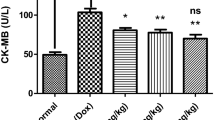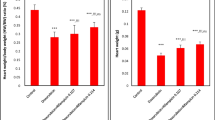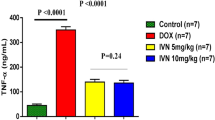Abstract
The major factor contributing to doxorubicin (DXR)-induced cardiotoxicity is the insufficiency of antioxidant defense mechanisms. As a model of acute cardiotoxicity with DXR, ten-week-old golden hamsters were given DXR (5 mg/kg) intravenously, and the toxicity was investigated by monitoring ECG changes. Complete A-V block and cardiac arrest on the ECG were observed in DXR-treated hamsters. DXR-induced edema and fragmentation of myofibrils were observed by electron-micrograph. Pretreatment with interleukin-1β(10 or 1μg/body) 12 or 24 hrs before prevented these changes, but pretreatment with tumor necrosis factorα had no effect.
Similar content being viewed by others
Abbreviations
- DXR:
-
doxorubicin
- IL-1:
-
interleukin-1
- Mn SOD:
-
manganous superoxide dismutase
- TNF:
-
tumor necrosis factor
References
Pigram WJ, Fuller W, Hamilton LD. Stereochemistry of intercalation: intercalation of Daunomycin with DNA. Nat New Biol, 1972; 235: 17–9.
Berlin V, Hanseltine WA. Reduction of Adriamycin to a sequinone-freeradical by NADPH cytochrome P-450 reductase produces DNA cleavage in a reaction mediated by molecular oxygen. J Biol Chem, 1981; 256: 4747–56.
Tritton TR, Yee G. The anticancer agent Adriamycin can be actively cytotoxic without entering cells. Science (Wash. DC), 1982; 217: 248–50.
Goormaghtigh E, Chatelain P, Caspers J, Ruysschart JM. Evidence of a specific complex between Adriamycin and negatively charged phospholipids. Biochim Biophys Acta, 1980; 597: 1–14.
Goodman J, Hochstein P. Generation of free radicals and lipid peroxidation by redox cycling of Adriamycin and Daunomycin. Biochem Biophys Res Commun, 1977; 77: 797–803.
Bachur NB, Gordon SL, Gee MV, Kon H. NADPH cytochrome P-450 reductase activation of quinone anticancer agents to free radicals. Proc Natl Acad Sci USA, 1979; 76: 954–57.
Fisher J, Ramakrishnan K, Becvar E. Direct enzyme-catalized reduction of anthracyclines by reduced nicotinamide adenine dinucleotide. Biochemistry, 1983; 22: 1347–55.
Handa K, Sato S. Generation of free radicals of quinone group containing anticancer chemicals in NADPH-microsomes system as evidenced by initiation of sulfite oxidation. Gann, 1975; 66: 43–7.
Thayer WS. Adriamycin stimulates superoxide formation in submitochondrial particles. Chem Biol Interact, 1977; 19: 265–78.
Thornallex PJ, Dodd NJF. Free radical production from normal and adriamycin-treated rat cardiac sarcomes. Biochem Pharmacol. 1985; 34: 669–74.
Myers CE, McGuire WP, Liss RH, Ifrim I, Grotzinger K, Youg RC. Adriamycin: the role of lipid peroxidation in cardiac toxicity and tumor response. Science (Wash. DC.), 1977; 197: 165–7.
Doroshow JH, Locker GY, Ifrim I, Myers CE. Prevention of doxorubicin cardiac toxicity in the mouse by N-acetylcysteine. J Clin Invest, 1981; 68: 1053–64.
Lenzhofer R, Magometshnigg D, Dudczac R, Cerni C, Bolebruch C, Moser K. Indication of reduced doxorubin-induced cardiac toxicity by additional treatment with antioxidative substances. Experientia, 1983; 39: 62–4.
Kanter MM, Hamin RL, Unuerferth DV, Davis HW, Merola AJ. Effect of exercise training on antioxidant enzymes and cardiotoxicity of doxorubicin. J Appl Physiol, 1985; 59: 1298–303.
Revis NW, Marusic N. Glutathione peroxidase activity and selenium concentration in the hearts of doxorubicin-treated rabbits. J Mol Cell Cardiol, 1978; 10: 945–51.
Wang YM, Madanat FF, Kimball JC, Gleiser CA, Ali MD, Kaufman MW, Van Eys J. Effect of vitamin E against Adriamycin-induced toxicity in rabbits. Cancer Res, 1980; 40: 1022–7.
Wong GHW, Goeddel DV. Induction of manganous superoxide dismutase by tumor necrosis factor: Possible protective mechanism. Science, 1988; 242; 941–4.
DiSilvestro RA, David EA, Collignon C. Interleukin 1 slowly increases lung fibroblast Cu-Zn superoxide dismutase activity levels. PSEBM, 1991; 197: 197–200.
Nishida T, Nishino L, Takano M, Kawai K, Bando K, Masui Y, Nakai S, Hirai Y. cDNA cloning of IL-1 beta from mRNA of U937 cell line. Biochem Biophys Res Commun.s 1987; 143: 345–52.
Kikumoto Y, Hong YM, Nishida T, Nakai S, Matui Y, Hirai Y. Purification and characterization of recombinant human interleukin-1 beta produced in Escherichia coli. Biochem Biophys Res Commun. 1987; 147: 315–21.
Yamada M, Furutani Y, Notake M, Yamagishi J, Yamayoshi M, Fukui T, Nomura H, Komiya M, Kuwashima J, Nakano K, Sohmura Y, Nakamura S. Efficient production of human tumour necrosis factor in Esherichia coli. J Biotech. 1985; 3: 141–53.
Mettler FP, Young DM, Ward JM. Adriamycin-induced cardiotoxicity (cardiomyopathy and congestive heart failure) in rats. Cancer Res. 1977; 37: 2705–13.
Wakabayashi T, Oki T, Tone H, Hirano S, Omori K. A comparative electron microscopic study of aclacinomycin and adriamycin cardiotoxicities in rabbits and hamsters. J Electron Microsc. 1980; 29: 106–18.
Lazzarino G, Viola AR, Mulieri L, Rotilio G, Mavelli I. Prevention by fructose-1,6-bisphosphate of cardiac oxidative damage induced in mice by subchronic doxorubicin treatment. Cancer Res.s 1987; 47: 6511–16.
Alderton P, Gross J, Green MD. Role of (±)-1,2-bis(3.5-dioxopiperazinyl-1-yl)propane (ICRF-187) in modulating free radical scavenging enzymes in doxorubicin-induced cardiomyopathy. Cancer Res. 1990; 50: 5136–42.
Harman EH, Schen P, Farmar RM. Influence of Pharmacologic or physiologic pretreatment on acute daunomycin cardiac toxicity in the hamster. Toxicol Applied Pharmacol. 1970; 16: 335–44.
Tone H, Hirano S, Shirai M, Kumagai H, Okajima Y, Wakabayashi T. Effect of (2″R)-4′-0-tetrahydropyranyladriamycin, a new antitumor anitibiotic, on the cardiac function of hamsters. Jap J Antibiotics, 1986; 39: 547–68.
Davies KJA, Doroshow JH, Hochstein P. Mitochondrial NADPH dehydrogenase-catalized oxygen radical production by adriamycin and the relative inactivity of 5-iminodaunorubicin. FEBS Lett, 1983; 153: 227–30.
Wong GHW, Goeddel DV. Induction of manganous superoxide dismutase by tumor necrosis factor: Possible protective mechanism. Science, 1988; 242: 941–4.
Matsuda A, Longo DL, Kobayashi Y, Apella E, Oppenheim JJ, Matsushima K. Induction of mitochondrial manganese superoxide dismutase by interlerkin 1. FASEB, 1988; 2: 3087–91.
Neta R, Oppenheim JJ. Cytokines in therapy of radiation injury. Blood, 1988; 72: 1093–5.
Neta R, Douches S, Oppenheim JJ. Interleukin 1 is a radioprotector. J Immunol, 1986; 136: 2483–5.
Laver J, Abboud M, Gasparetto C, Gillio A, Smith C, O'Reilly RJ, Moore MAS. Effects IL-1 on hematopoietic progenitores after myelosuppressive chemotherapy. Biotherapy 1989; 1: 293–300.
Author information
Authors and Affiliations
Rights and permissions
About this article
Cite this article
Yoshida, T., Okumura, H., Kaya, H. et al. Prevention of doxorubicin-induced cardiotoxicity by recombinant interleukin-1 in hamsters. Biotherapy 6, 125–132 (1993). https://doi.org/10.1007/BF01877425
Accepted:
Issue Date:
DOI: https://doi.org/10.1007/BF01877425




